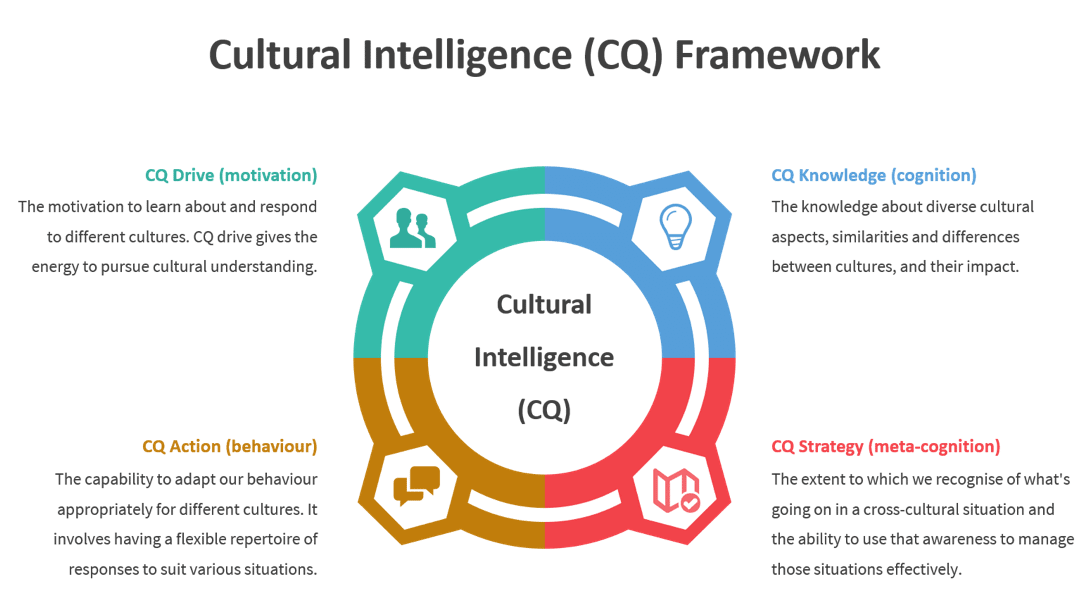board-dynamics
Cultural Intelligence (CQ) for Not-for-Profit Organisations
Published: May 26, 2020
Read Time: 6 minutes

If your not-for-profit organisation serves a diverse community, has stakeholders (staff, volunteers, donors) who come from a culturally and linguistically diverse (CALD) background, or operates in multiple different locations, then cultural intelligence has a direct effect on the success of your programs and services.
Culture refers to the total way of life of a group of people. It comprises everything that a group of people thinks, says, does and makes — deposit of knowledge, systems, beliefs, values, roles, art, habits, cuisines, symbols and attitudes. Culture is learned and transmitted from generation to generation.
Cultural Intelligence (CQ) is the capability to function effectively across a variety of cultural contexts. The emphasis is not only on understanding different cultures, but also on problem solving and effective adaptations. People with high CQ possess a set of knowledge, skills, and abilities needed to recognise, understand, reflect on, and adapt to different settings.
Cultural intelligence is related to Emotional Intelligence (EQ), but it picks up where emotional intelligence leaves off. Emotional intelligence is the ability to identify and manage our own emotions and the emotions of others. Cultural intelligence is the ability to relate to and communicate effectively with people from other cultures. Both intelligences emphasise the ability to have good self-awareness, communicate and connect with others and practice empathy. However, cross-cultural challenges can rarely be resolved by emotional intelligence alone because what works well in one culture may not work well in another.
Consider what happened when cultural intelligence was missing in these not-for-profit scenarios:
Zaira, an immigrant from South Asia, entered a non-profit treatment center for alcohol dependence. The center expected participants to notify their family members about being in treatment. Staff members were shocked when Zaira’s parents disowned her. She had "shamed" the family by publicly admitting her drinking problem. Zaira never came again to the center and eventually experienced depression.Jane was tasked to conduct feedback interviews with participants from a minority background that her not-for-profit served. During the interview, she heard lots of ‘OK’ and interpreted this as good feedback for the not-for-profit program. She then recommended the program to continue. But to her surprise, the drop-out rate from the program continued to be high. It appeared that the word ‘OK’ was the standard response to say ‘I understand’ in the participants’ culture. It did not necessarily represent ‘good feedback’. Jane completely missed the cultural cues during the feedback interview, and this resulted in the loss of participants from the program.- Attract more participants to the organisation’s program (increase beneficiaries).
- Serve the beneficiaries more effectively and deliver more value for them.
- Better understand a beneficiary’s presenting issues and match that person with the appropriate programs and services.
- Reduce misunderstandings and conflicts that may arise from different perceptions, cultural values and opinions among team members.
- Recruit and retain diverse board members, staff members and volunteers.
- Achieve financial stability through larger grants and higher donation rates.
- Generate a bigger impact and create more positive change in the community that the organisation serves.
There are four capabilities of Cultural Intelligence (CQ) according to David Livermore’s book ‘The Cultural Intelligence Difference’ (2011):
1. CQ Drive (motivation)
This refers to the motivation to learn about and respond to different cultures. When we make the effort to learn about a new culture, our mind starts to open up to new possibilities. For the not-for-profit organisation, CQ drive gives the energy and self-confidence to pursue the necessary cultural understanding and planning for the programs and services delivered.
CQ drive asks the questions “Do you have the motivation and drive to work through the challenges that inevitably accompany cross-cultural situations? What are your motivations and how can we link these to build your cultural intelligence?”. These questions often get overlooked when dealing with issues like cultural diversity. Not-for-profit organisations have the tendency to immediately jump in with training to help people deal with cultural differences. But without the ample
2. CQ Knowledge (cognition)
This refers to the knowledge about similarities and differences between cultures. The emphasis is not on being an expert about every culture we encounter, but to what extent do we understand some core cultural differences and their impact on us and others. CQ knowledge provides not-for-profit organisations with an understanding of cultural cues, values and habits, and how it shapes behaviour of the members we work with and the communities that we serve.
There are many paths to increase CQ knowledge for not-for-profit boards and members. Some of them include:
- Studying and experiencing other cultures: attending cultural celebrations, watching movies from different cultures, going to restaurants with ethnically different food, reading about other cultures and many more.
- Learning a new language: Languages are so much more than words. Environmental factors and societal norms shape the development of language and language further shapes culture. Language allows us to interact with people and to pick up on all kinds of things we otherwise miss.
- Recruiting a CQ coach: A CQ coach or guide will use questions to guide us and offer support and feedback. He/she should be careful not to oversimplify things while also offering some helpful, neutral stereotypes. Reading an explanation about cultural issues in a book is very different from receiving an explanation from someone who has lived through the experience and culture.
3. CQ Strategy (meta-cognition)
This refers to the extent to which we recognise what’s going on in a cross-cultural situation and the ability to use that awareness to manage those situations effectively. For not-for-profit organisations, it is the capability to formulate robust, culturally sensitive strategies to manage the operations of the organisation and deliver bigger impact for the people that the organisation serves.
Two useful tips in building CQ strategy are to plan interactions and manage expectations. It will be useful to plan our interactions by considering some basic norms, essential greetings, appropriate discussion topics and communication styles. Proactively managing expectations and anticipating experience are also essential to help us realise the outcomes that we want to achieve through our not-for-profit programs and activities.
4. CQ Action (behaviour)
This is the capability to adapt our behaviour appropriately for different cultures. It involves having a flexible repertoire of responses to suit various situations whilst remaining true to ourselves. For not-for-profit organisations, it is the ability to put some concrete actions in place to engage board members, staff, volunteers, donors and beneficiaries in a culturally appropriate and effective manner.
There are three sub-dimensions of CQ action which influence our interactions and work cross-culturally:
- Nonverbal: gestures, facial expressions and cues.
- Verbal: language, accent tone and pronunciation.
- Speech acts: the way we alter communications to effectively achieve a goal in a cross-cultural situation (e.g. the way we provide feedback, gratitude, etc).

Developing our skills in cultural intelligence is a continuous journey, not a single event that culminates in an ‘ultimate outcome’. It is a dynamic learning process in which ongoing skills development and training, as well as the aptitude to explore new concepts, are necessary to build the capability.
Reference
The Cultural Intelligence Difference by David Livermore (2011)
Share this Article
Recommended Reading
Recommended Viewing
Author
-
Co-Founder
Hoshizora Foundation
- About
-
Wenda is the co-founder of Hoshizora Foundation, an education not-for-profit, and currently serves as the Board Chair. Based in Sydney (Australia), she is a also a Director for a global consulting firm leading teams to provide services on ESG, risk management, corporate governance, strategy activation, and business model management. She is passionate about social impact and advising several ESG and community investment programs globally. Being trilingual in English, Japanese and Indonesian, Wenda has given lectures, workshops, and developed knowledge-sharing programs for local and global institutions.
Found this article useful or informative?
Join 5,000+ not-for-profit & for-purpose directors receiving the latest insights on governance and leadership.
Receive a free e-book on improving your board decisions when you subscribe.
Unsubscribe anytime. We care about your privacy - read our Privacy Policy .










